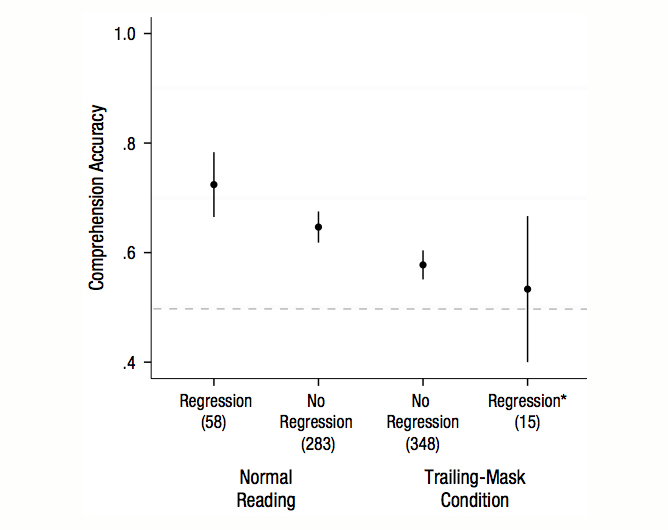Here is some research I have been doing.

Parafoveal Processing in Reading
Readers constantly make quick eye movements --saccades-- from one word to another in order to directly view the next to-be-processed word where vision is sharpest. However, a reader's ability to preview a word in parafoveal vision provides a head-start on processing it, contributing not only to them making eye movements sooner (i.e., reading faster) but also to them beginning to understand a word before even looking at it. Prior to that, the reader had processed the previous words in the sentence, which changes the way readers respond to previews of upcoming words. Much of my research focuses on what aspects of words readers pre-activate during reading, how these representations are used to make reading more efficient, and what aspects of the reader or the text support and constrain this process.
PDFs:
[Review: new]
[Review: old]
[Preview &
identification]
[Preview & regressions]
[Reverse Preview Benefit]
[Preview Plausibility]
[Preview & Context]
[Synonym Preview Benefit]
[Simulations and Theory]
[Corpus vs. Manipulation]
[Semantic Preview Revisited]
[Capitalization]
[Transposed Words]
[Abbreviations]
Collaborators:
[Keith Rayner]
[Bernhard Angele]
[Klinton Bicknell]
[Denis Drieghe]
[Mallorie Leinenger]
[Erik Reichle]
[Tim Slattery]
[Titus von der Malsburg]
Student Collaborators: [Raymond Berry] [Annie Jia] [Michelle Lee] [Michael
Reiderman]
[Tara Tenenbaum]

Speed Reading
We all want to read faster. But faster doesn't necessarily mean better. Speed reading has been intriguing at least since Evelyn Wood introduced her Reading Dynamics training program in 1959, and has increased in popularity with the proliferation of speed reading apps. Scientists know a great deal about the reading process that sheds doubt on many of the proponents' claims. Importantly there is a trade-off between speed and accuracy--it is implausible to triple your reading speed with the same understanding of the text as reading at normal speed. Particularly, the inability to make a regression and re-read the text has negative consequences for comprehension. Skimming serves well for a fast and cursory understanding, but the best way to maintain high comprehension and reading efficiency is to practice reading and to become a more skilled language user (e.g., through increased vocabulary). This is because language skill is at the heart of reading speed.
PDFs: [Review] [Regressions & Comprehension]
Collaborators: [Keith Rayner] [Michael Masson] [Molly Potter] [Randy Tran] [Becky Treiman]
Press: [WIRED 9.8.15] [KPBS 5.8.14]

Task Influences on Processing Behavior
Humans are flexible with respect to how they process visual information, depending on task goals. This cognitive flexibility is useful because some aspects of a stimulus are more relevant for a particular goal than others. For example, when proofreading a text for spelling errors, the predictability of a word (i.e., how expected it is) is used more when checking for spelling errors that produce wrong, but real words (e.g., trial for trail) than those that produce nonwords (e.g., trcak for track) in the sentence "The marathon runners trained on the trcak/trial behind the high school." Similarly, whether a photograph is in black-and-white or color is more relevant to a decision about which of two photographs is older than to a decision about which one the decision-maker likes more. Eye tracking experiments show that people respond differently to specific word or image properties based on their intentions.
PDFs: [Proofreading] [Decision Making] [More Decision Making]
Collaborators: [Keith Rayner] [Klinton Bicknell] [Roger Levy] [Craig McKenzie]
Student Collaborators: [Raynmond Berry] [Cainen Gerety] [Ian Howard]

Thinking Ahead in Speech Production
It is clear that speakers do not think of, activate, plan, and articulate one word at a time; to some extent, they plan upcoming words simultaneously. However, the speaker's planning is determined by pressures placed on the production system, not anticipation of what the comprehender is likely to (mis)interpret. When speaking about objects in our environment, part of what makes us able to speak quickly is the ability to access information from upcoming objects before we look at them, similar to preview benefit in reading. Speakers can restrict para- or extra-foveal processing with attention. Bilinguals maintain control of over which language they speak when reading aloud by looking at word as they speak it.
PDFs:
[Review]
[Preview Benefit in Speaking]
[Intention To Name]
[Bilinguals Reading Aloud]
[Production vs. Comprehension]
Collaborators: [Keith Rayner] [Victor Ferreira] [Tamar Gollan]
Student Collaborators: [Annie Jia]
